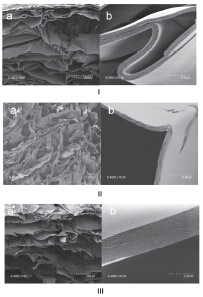| [1] Molina, I.; Li, S. M.; Martinez, M. B.; Vert, M. Biomaterials 2001, 22, 363.
[2] Fioretta, E. S.; Fledderus, J. O.; Burakowska-Meise, E. A.; Baaijens, F. P. T.; Verhaar, M. C.; Bouten, C. V. C. Macromol. Biosci. 2012, 12, 577.
[3] Chen, S. H.; Tsao, C. T.; Chang, C. H.; Lai, Y. T.; Wu, M. F.; Chuang, C. N.; Chou, H. C.; Wang, C. K.; Hsieh, K. H. Mater. Sci. Eng., C 2013, 33, 2584.
[4] Valmikinathan, C. M.; Mukhatyar, V. J.; Jain, A.; Karumbaiah, L.; Dasari, M.; Bellamkonda, R. V. Soft Matter 2012, 8, 1964.
[5] Chen, S. C.; Wu, Y. C.; Mi, F. L.; Lin, Y. H.; Yu, L. C.; Sung, H. W. J. Controlled Release 2004, 96, 285.
[6] Mourya, V. K.; Inamdar, N. N.; Tiwari, A. Adv. Mater. Lett. 2010, 1, 11.
[7] Yin, X.; Zhou, G.; Wang, C. Y.; Liu, Z. W. J. Wuhan Polytechnic Univ. 2008, 27, 18. (殷雪, 周岿, 王春颖, 刘章武, 武汉工业学院学报, 2008, 27, 18.)
[8] Huang, P. M.S. Thesis, J. Ocean Univ. China, Qingdao, 2009. (黄攀, 硕士论文, 中国海洋大学, 青岛, 2009.)
[9] Chen, L.; Tian, Z.; Du, Y. Biomaterials 2004, 25, 3725.
[10] Wang, G.; Lu, G. Y.; Ao, Q.; Gong, Y. D.; Zhang, X. F. Biotechnol. Lett. 2010, 32, 59.
[11] Hoffman, A. S. Adv. Drug Delivery Rev. 2002, 54, 3.
[12] Hu, Y. F.; Liu, Y. F.; Qi, X.; Liu, P.; Fan, Z. Y.; Li, S. M. Polym. Int. 2012, 61, 74.
[13] Malinen, M. M.; Kanninen, L. K.; Corlu, A.; Isoniemi, H. M.; Lou, Y. R.; Yliperttula, M. L.; Urtti, A. O. Biomaterials 2014, 35, 5110.
[14] Mishra, D.; Bhunia, B.; Banerjee, I.; Datta, P.; Dhara, S.; Maiti, T. K. Mater. Sci. Eng., C 2011, 31, 1295.
[15] Hennink, W. E.; Van Nostrum, C. F. Adv. Drug Delivery Rev. 2002, 54, 13.
[16] Cheung, H. K.; Han, T. T. Y.; Marecak, D. M.; Marecak, D. M.; Watkins, J. F.; Amsden, B. G.; Flynn, L. E. Biomaterials 2014, 35, 1914.
[17] Vaghani, S. S.; Patel, M. M.; Satish, C. S. Carbohydr. Res. 2012, 347, 76.
[18] Drury, J. L.; Mooney, D. J. Biomaterials 2003, 24, 4337.
[19] Van Vlierberghe, S.; Dubruel, P.; Schacht, E. Biomacromolecules 2011, 12, 1387.
[20] Guan, J.; Xu, H. X.; Huang, Y. F.; Tian, K.; Shao, Z. Z.; Chen, X. Acta Chim. Sinica 2010, 68, 89. (管娟, 许惠心, 黄郁芳, 田琨, 邵正中, 陈新, 化学学报, 2010, 68, 89.)
[21] Tseng, H. J.; Tsou, T. L.; Wang, H. J.; Hsu, S. H. J. Tissue Eng. Regen. Med. 2013, 7, 20.
[22] Lin, Y. W.; Li, L. F.; Li, G. W. Acta Chim. Sinica 2012, 70, 2246. (林友文, 李立凡, 李光文, 化学学报, 2012, 70, 2246. )
[23] Zhang, Y. L.; Tao, L.; Li, S. X.; Wei, Y. Biomacromolecules 2011, 12, 2894.
[24] Weng, L.; Romanov, A.; Rooney, J.; Chen, W. Biomaterials 2008, 29, 3905.
[25] Fan, L. H.; Sun, Y.; Xie, W. G.; Zheng, H.; Liu, S. H. J. Biomater. Sci., Polym. Ed. 2012, 23, 2119.
[26] Li, X. Y.; Kong, X. Y.; Zhang, Z. L.; Nan, K. H.; Li, L. L.; Wang, X. H.; Chen, H. Int. J. Biol. Macromol. 2012, 50, 1299.
[27] Zhu, S. J.; Liu, F. Q.; Wang, J. Z.; Su, F.; Li, S. M. Chem. J. Chin. Univ. 2014, 35, 863. (朱寿进, 刘法谦, 王璟朝, 宿烽, 李速明, 高等学校化学学报, 2014, 35, 863.)
[28] ArguKelles-Monal, W.; Goycoolea, F. M.; Peniche, C.; Higuera-ciapara, I. Polym. Gels Networks 1998, 6, 429.
[29] Zhang, Y.; Wu, X.; Han, Y.; Mo, F.; Duan, Y. R.; Li, S. M. Int. J. Pharm. 2010, 386, 15.
[30] Martel-Estrada, S. A.; Olivas-Armendariz, I.; Martinez-Perez, C. A.; Hernandez, T.; Acosta-Gomez, E. I.; Chacon-Nava, J. G.; Jimenez-Vega, F.; Garcia-Casillas, P. E. J. Mater. Sci.-Mater. Med. 2012, 23, 2893. |
